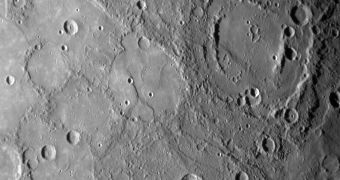During the fly-by around Mercury, the Mercury Surface, Space Environment, Geochemistry and Ranging, or MESSENGER, observed what seemed to be scalloped edged cliffs which had been mostly created by the shrinking action of the planet as it cooled in time. The same evidence has been observed by the Mariner 10 orbiter during its three fly-bys around the planet, albeit Mariner 10 images seem to suggest that they could have only formed in the early history of Mercury.
The real question is: why aren't any older features remnant of the shrinking of Mercury on its surface. Virginia Tech professor Scott D. King believes that the loss of heat from the mantle through the crust may have also had an important role in the dynamics of the formation of scalloped edges. Thus, while waiting for the MESSENGER spacecraft to collect gravity and topographic data in order to test this theory, professor King started creating a computer simulation of the silicate mantle of Mercury to model the three-dimensional heat convection patterns which take place beneath the surface.
The simulations were run on the High-Performance Earth Simulation System, a high-speed, high-capacity 768-core Dell computer cluster, housed by the Virginia Tech geoscience department. Amongst some of the most popular explanations given by scientists for the contraction of Mercury, we can find cooling and core formation, tidal effect from gravitational interactions and even impacts and mantle convection.
"The idea that contraction due to cooling in the cause of these features has been around for a long time and makes a lot of sense," says professor King, however most of these contraction patterns seem to have odd orientation. One might think that this is just an artifact, and can be found only in certain areas on the planet's surface, although this is clearly not the case. The only process that could explain the strange orientation would be mantle heat convection.
According to King, mantle convection of Mercury would form long and linear rolls on the surface, opposite to compression alone which would create a random pattern. Further still, it is now obvious that these features created by contraction, assisted by heat convection, are much more different that what we have seen on all the other rocky planets in the solar system, because Mercury is much smaller than the others - meaning it would have a thinner mantle and a larger core in relation to its size.
"On Venus, Earth and Mars, the hot material coalesces into cylindrical plumes, not linear sheets. That could influence the tectonics at the surface and the convection within the iron core, which is most likely what is responsible for Mercury's magnetic field," said professor King.
This basically means that the orientation of the features is determined only by mantle convection, thus MESSENGER could collect data to confirm the model, as all evidence points towards a still active convection process. It is clear that scalloped edged cliffs stopped forming a couple of billions of years ago, but the planet is so cool now that not even mantle convection could further modify the structure of the surface.
"I think that if we want to figure out how the Earth go to be the way it is, we need to understand how the other planets go to be the way they are too," said King.

 14 DAY TRIAL //
14 DAY TRIAL //